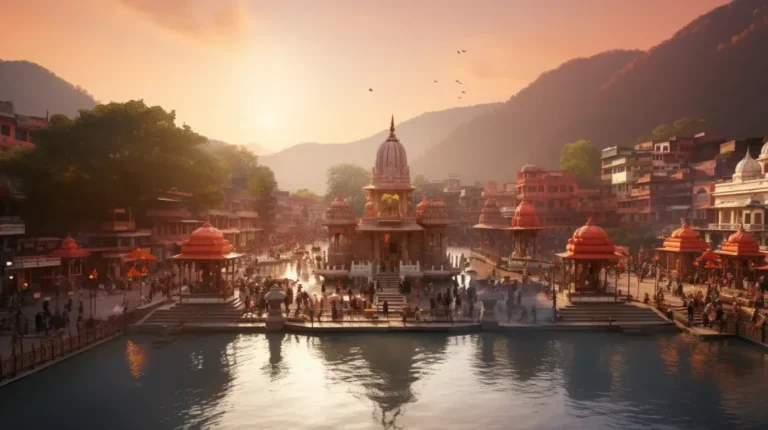The Pilgrim’s Path: Unveiling Hidden Religious Gems Across Continents
The Pilgrim’s Path: Unveiling Hidden Religious Gems Across Continents is a captivating exploration of lesser-known religious sites across the globe. This enlightening journey takes us through ancient temples in Asia, sacred pilgrimage routes in Europe, mystical monasteries in the Middle East, spiritual retreats in South America, hidden shrines in Africa, and ancient relics in Central America.
Delving into sacred caves in Oceania and uncovering secret synagogues in Europe, this book offers a unique perspective on the diverse religious traditions that enrich our world. With a professional and informative writing style, this guide is designed to appeal to an audience seeking a deeper understanding of the religious heritage and cultural significance of these hidden gems.
This book is a must-read for those who yearn to expand their knowledge and appreciation of global spirituality.
Key Takeaways
- There are numerous ancient temples, pilgrimage routes, and mystical monasteries across Asia and Europe.
- Spiritual retreats, hidden shrines, and sacred mountains also offer unique religious experiences.
- There are hidden synagogues and Jewish heritage sites in Europe that are important for cultural heritage and inclusivity.
- The Pilgrim’s Path unveils these hidden religious gems across continents, showcasing their significance and promoting religious exploration.
Ancient Temples in Asia
Ancient temples in Asia hold a profound religious significance, beckoning pilgrims from all corners of the world to embark on a spiritual journey. These awe-inspiring structures, adorned with intricate carvings and vibrant colors, serve as sanctuaries for worshippers, offering a space for introspection, meditation, and connection with the divine.
From the majestic Angkor Wat in Cambodia to the serene Borobudur in Indonesia, each temple tells a story of faith, devotion, and cultural heritage. These architectural marvels not only provide a glimpse into the past but also offer a window into the spiritual practices and beliefs that continue to shape the lives of millions.
Whether you are seeking enlightenment, seeking solace, or simply marveling at the beauty of human creativity, the ancient temples of Asia provide a sacred space where one can find peace, inspiration, and a deeper understanding of the world’s diverse religious traditions.
Sacred Pilgrimage Routes in Europe
Europe is home to a rich tapestry of sacred pilgrimage routes, each steeped in historical significance and offering modern pilgrims transformative experiences. These routes, such as the Camino de Santiago in Spain and the Via Francigena in Italy, have been traveled by countless pilgrims for centuries, leaving behind a trail of spiritual devotion and personal growth.
Today, these sacred paths continue to inspire individuals from all walks of life, providing a unique opportunity to connect with the past, explore diverse cultures, and embark on a profound inner journey.
Historical Significance of Routes
The historical significance of the sacred pilgrimage routes in Europe can be traced back centuries, with their enduring impact on religious and cultural practices evident even today. These routes have served as pathways of faith for countless pilgrims, offering a tangible connection to their spiritual beliefs.
Here are four key aspects that highlight the historical importance of these routes:
- Spiritual Journeys: Pilgrimage routes have allowed believers to embark on transformative journeys, seeking solace, enlightenment, and a deeper connection with their faith.
- Cultural Exchange: These routes have facilitated the exchange of ideas, art, and architecture, fostering a rich cultural tapestry across Europe. Pilgrims from different regions and backgrounds would meet along the way, sharing their customs and traditions.
- Economic Impact: The pilgrimage routes have played a vital role in the development of towns and cities, as they provided a source of income for local communities through the provision of food, lodging, and other services.
- Preservation of Heritage: These routes have preserved the historical and architectural heritage of Europe, as many sacred sites and monuments were constructed along these paths. They serve as a tangible link to the past, reminding us of the enduring power of faith and the importance of preserving our cultural legacy.
The historical significance of these sacred pilgrimage routes cannot be overstated. They continue to inspire and unite people from various backgrounds, offering a glimpse into the shared spiritual and cultural heritage of Europe.
Modern Pilgrimage Experiences
Pilgrimage routes in Europe continue to attract a steady stream of modern-day believers, offering them a profound and transformative spiritual experience. These sacred paths, woven with centuries of devotion, provide pilgrims with an opportunity to connect with their faith, history, and themselves.
Europe is home to a multitude of pilgrimage routes, each with its own unique charm and significance. One such route is the Camino de Santiago in Spain, where pilgrims follow in the footsteps of countless others on a journey that culminates at the tomb of St. James.
Another popular pilgrimage route is the Via Francigena, which stretches from Canterbury to Rome, allowing pilgrims to traverse stunning landscapes while following the footsteps of medieval pilgrims.
Additionally, the St. Olav Ways in Norway offer pilgrims a chance to immerse themselves in the breathtaking beauty of Nordic landscapes while honoring the legacy of St. Olav.
These pilgrimage routes not only provide a physical journey but also serve as a spiritual quest, allowing pilgrims to discover a deeper connection to their faith and themselves.
As we delve into the mystical monasteries of the Middle East, we will explore how these ancient sanctuaries continue to inspire and guide seekers on their spiritual journey.
Mystical Monasteries in the Middle East
Exploring the mysticism of the Middle East, one cannot overlook the enchanting allure of its mystical monasteries. These spiritual retreats offer a glimpse into the rich religious heritage of the region and provide a serene escape from the bustling cities.
Here are four mystical monasteries in the Middle East that are worth exploring:
- Saint Catherine’s Monastery in Egypt: Nestled at the foot of Mount Sinai, this ancient monastery is a UNESCO World Heritage site. It houses a priceless collection of religious artifacts, including a burning bush believed to be the same one encountered by Moses.
- Mar Saba Monastery in Palestine: Perched on a rocky cliff overlooking the Kidron Valley, this Greek Orthodox monastery is a haven of tranquility. Its breathtaking views and austere architecture create a sense of serenity.
- Deir Mar Musa in Syria: Located amidst the rugged landscapes of the Syrian desert, this Syriac Catholic monastery is known for its vibrant frescoes and peaceful atmosphere. It offers visitors a chance to experience the spiritual traditions of the Syrian Christian community.
- Mar Behnam Monastery in Iraq: Situated near the city of Mosul, this ancient Assyrian monastery is a testament to centuries of Christian heritage. Despite the recent conflicts, it continues to stand as a symbol of resilience and faith.
These mystical monasteries in the Middle East are not only architectural marvels but also serve as spiritual sanctuaries that inspire seekers from around the world. Exploring these hidden gems allows us to connect with the profound religious traditions and cultural diversity of the region.
Spiritual Retreats in South America
South America boasts a diverse array of spiritual retreats that offer seekers a chance to delve into the region’s rich religious traditions. From the majestic Andes to the lush Amazon rainforest, this vibrant continent is home to a multitude of sacred spaces where individuals can embark on a transformative journey of self-discovery.
Whether it’s the ancient Inca ruins in Peru, the mystical Ayahuasca ceremonies in Brazil, or the serene Buddhist retreats in Argentina, South America provides a haven for those seeking spiritual enlightenment. These retreats offer a unique opportunity to connect with nature, explore indigenous wisdom, and engage in contemplative practices that foster inner peace and personal growth.
As you delve into the spiritual retreats of South America, prepare to be enchanted by the profound spirituality and cultural diversity that permeate this extraordinary continent.
Hidden Shrines in Africa
Africa, a continent rich in cultural and spiritual diversity, is home to numerous hidden shrines that hold significant religious importance. These African pilgrimage destinations offer a glimpse into the lesser-known sacred sites, where devotees can embark on a spiritual journey and connect with ancient traditions.
From the ancient rock-hewn churches of Lalibela in Ethiopia to the mystical Sufi shrines in Senegal, Africa’s hidden shrines are waiting to be discovered and cherished by those seeking a deeper connection with their spirituality.
African Pilgrimage Destinations
A multitude of hidden shrines can be found across the vast continent of Africa, each offering unique religious experiences for pilgrims. These African pilgrimage destinations are not only sacred places but also hold cultural significance for the communities that surround them. Here are four hidden shrines in Africa that are worth exploring:
- Lalibela, Ethiopia: Known for its rock-hewn churches, Lalibela is a UNESCO World Heritage site and an important pilgrimage destination for Ethiopian Orthodox Christians.
- Djenne, Mali: The Great Mosque of Djenne is one of the largest mud-brick structures in the world and a symbol of Islamic architecture. It attracts pilgrims from all over West Africa during the annual Djenne Festival.
- Mount Sinai, Egypt: This sacred mountain is believed to be the place where Moses received the Ten Commandments. Pilgrims climb to the summit to witness breathtaking sunrise views.
- Kano, Nigeria: The Emir’s Palace in Kano is not only the residence of the Emir but also a center for Islamic learning and worship. Pilgrims come to seek blessings and guidance.
These hidden shrines in Africa offer spiritual seekers an opportunity to connect with ancient traditions and experience the rich tapestry of Africa’s religious heritage.
Lesser-Known Sacred Sites
Continuing our exploration of African pilgrimage destinations, we now turn our attention to the lesser-known sacred sites, hidden shrines that hold both religious and cultural significance.
These hidden gems, tucked away in the corners of Africa, offer a unique and enriching experience for pilgrims seeking a deeper connection to their faith. From the remote monasteries of Ethiopia to the sacred caves of Zimbabwe, these hidden shrines serve as beacons of spirituality, drawing devotees from far and wide.
Each site holds its own sacred rituals, customs, and beliefs, reflecting the diversity and richness of Africa’s religious tapestry. Whether it’s the ancient rock paintings in Algeria or the mystical waterfalls of Mali, these lesser-known sacred sites provide pilgrims with a profound sense of awe and wonder, inspiring them to embark on a transformative journey of the soul.
Sacred Mountains in North America
Which sacred mountains in North America hold significance for pilgrims and religious seekers?
North America is home to numerous sacred mountains that have been revered by indigenous peoples and spiritual seekers for centuries. These majestic peaks are not only breathtaking in their natural beauty, but they also hold deep religious and cultural significance.
Here are four sacred mountains in North America that continue to draw pilgrims and seekers from all over the world:
- Mount Shasta (California, USA): Considered a spiritual power center, Mount Shasta is believed to be a place of spiritual awakening and transformation.
- Bear Butte (South Dakota, USA): Sacred to many Native American tribes, Bear Butte is a place of prayer, vision quests, and spiritual renewal.
- Mount Currie (British Columbia, Canada): Revered by the Lil’wat Nation, Mount Currie is seen as a spiritual guardian and place of connection to the Creator.
- Mount Taylor (New Mexico, USA): A sacred mountain to several Native American tribes, Mount Taylor is associated with healing, protection, and spiritual guidance.
These sacred mountains offer pilgrims and religious seekers the opportunity to connect with the divine, to seek enlightenment, and to deepen their spiritual journeys.
Lesser-known Pilgrimage Sites in Australia
The diverse continent of Australia boasts several lesser-known pilgrimage sites that offer spiritual seekers and pilgrims unique and transformative experiences.
One of these hidden gems is the Twelve Apostles, located along the Great Ocean Road in Victoria. These limestone pillars rising out of the Southern Ocean provide a breathtaking backdrop for reflection and contemplation.
Another lesser-known site is the Larapinta Trail in the Northern Territory, which stretches for over 223 kilometers and offers stunning views of the Australian Outback.
For those seeking a deeper connection with nature, the Dandenong Ranges in Victoria provide a serene and peaceful environment for spiritual retreats.
These lesser-known pilgrimage sites in Australia offer a chance to connect with the land, the culture, and oneself.
As we turn our attention to ancient relics in Central America, let us explore the rich history and spiritual significance of these sacred artifacts.
Ancient Relics in Central America
Central America is home to a wealth of ancient relics that offer a fascinating glimpse into the region’s rich history and spiritual heritage. Here are four remarkable ancient relics that can be found in Central America:
- Mayan Ruins: Central America is famous for its Mayan ruins, such as Tikal in Guatemala and Copan in Honduras. These archaeological sites showcase the advanced architectural and mathematical skills of the Mayan civilization.
- Stone Spheres of Costa Rica: Discovered in the Diquis Delta, these perfectly round stone spheres have puzzled archaeologists for centuries. Their purpose and origin remain a mystery, adding an air of intrigue to the region’s ancient past.
- Jade Artifacts: Central America is known for its exquisite jade artifacts, which were highly valued by ancient civilizations. These artifacts, often adorned with intricate carvings, provide insight into the religious and cultural practices of the past.
- El Salvador’s Joya de Cerén: Known as the ‘Pompeii of the Americas,’ Joya de Cerén is a UNESCO World Heritage site that preserves the remains of a pre-Columbian farming village. The remarkably preserved structures and artifacts offer a unique glimpse into daily life during the Maya Classic period.
These ancient relics not only serve as a testament to Central America’s rich history but also provide a spiritual connection to the past, allowing visitors to appreciate the region’s cultural heritage.
Sacred Caves in Oceania
Located throughout Oceania, sacred caves hold significant religious and cultural importance in the region. These mystical caverns, carved by time and nature, serve as sacred spaces for indigenous communities, offering a connection to their ancestors and the divine. These caves are regarded as portals between the earthly realm and the spiritual world, where rituals, ceremonies, and spiritual practices are conducted.
In Oceania, the sacred caves are not only revered for their religious significance but also for their historical and cultural value. They are often adorned with ancient rock art, depicting stories of creation, mythical beings, and spiritual journeys. These intricate artworks provide a glimpse into the rich cultural heritage of the indigenous peoples of Oceania.
Exploring these sacred caves in Oceania offers visitors a unique opportunity to appreciate the deep spiritual traditions that have been preserved for generations. The energy within these caves is palpable, inviting visitors to reflect, meditate, and connect with the spiritual essence of the land.
As we delve into the hidden synagogues in Europe, let us continue our journey of discovery and explore the rich tapestry of religious heritage that spans across continents.
Hidden Synagogues in Europe
Europe is home to a rich and diverse Jewish heritage, with hidden synagogues serving as a testament to centuries of history. These historic Jewish sanctuaries are not only places of worship but also symbols of resilience and cultural identity.
Today, efforts are being made to preserve and protect these hidden gems, ensuring that future generations can appreciate and learn from the rich tapestry of European Jewish heritage.
Historic Jewish Sanctuaries
Exploring the rich history of Jewish worship, hidden synagogues offer a glimpse into the enduring legacy of Jewish communities across the European continent. These historic Jewish sanctuaries, often concealed within nondescript buildings or disguised as other structures, hold stories of perseverance, resilience, and faith. As we uncover these hidden gems, we are reminded of the deep-rooted connection between Jewish heritage and the lands they have inhabited for centuries.
Here are four remarkable hidden synagogues that breathe life into the past:
- The Great Synagogue of Florence, Italy: Tucked away in a medieval building, this synagogue is a testament to the vibrant Jewish community that once thrived in the heart of Renaissance Florence.
- The Old-New Synagogue in Prague, Czech Republic: Dating back to the 13th century, this synagogue is the oldest active one in Europe and preserves the spirit of Jewish life in Prague.
- The Spanish Synagogue in Prague, Czech Republic: A stunning Moorish-inspired architectural masterpiece, this synagogue stands as a symbol of a flourishing Jewish community during the late 19th century.
- The Portuguese Synagogue in Amsterdam, Netherlands: With its majestic interior and rich history, this synagogue serves as a sanctuary for Jewish traditions and a testament to the resilience of the Jewish people.
Hidden synagogues across Europe bear witness to the enduring Jewish heritage that has shaped the continent’s cultural tapestry. As we continue our journey into European Jewish heritage, let us uncover the stories of these sacred spaces and honor the communities that have called them home.
European Jewish Heritage
Uncovering the rich history of Jewish worship, hidden synagogues across the European continent reveal the enduring legacy of Jewish communities and their profound connection to the lands they have inhabited for centuries.
| Country | Hidden Synagogue |
|---|---|
| Poland | Nozyk Synagogue |
| Romania | Great Synagogue of Bucharest |
| Hungary | Dohány Street Synagogue |
| Czech Republic | Spanish Synagogue |
| Germany | Rykestrasse Synagogue |
In Poland, the Nozyk Synagogue stands as a testament to the resilience of the Jewish community, having survived the devastation of World War II. The Great Synagogue of Bucharest in Romania stands as a symbol of Jewish heritage and is a vibrant center of cultural activities. In Hungary, the Dohány Street Synagogue is not only one of the largest synagogues in the world but also houses a Jewish Museum and a Holocaust Memorial. The Spanish Synagogue in the Czech Republic showcases the rich Sephardic heritage, while the Rykestrasse Synagogue in Germany is a beautiful example of Moorish Revival architecture.
These hidden synagogues serve as reminders of the vibrant Jewish communities that once thrived in Europe and offer visitors a chance to learn about and appreciate the rich Jewish heritage of the continent.
Preservation Efforts Today
Preservation efforts for hidden synagogues in Europe are crucial in ensuring the continued recognition and safeguarding of these valuable religious and cultural landmarks. These efforts are a testament to the resilience and determination of communities to preserve their history and heritage.
Here are four reasons why the preservation of hidden synagogues in Europe is of utmost importance:
- Historical significance: Hidden synagogues provide a window into the rich Jewish history of Europe, allowing us to understand the challenges and triumphs of Jewish communities throughout the centuries.
- Cultural heritage: These synagogues are not just religious spaces but also cultural symbols, representing the traditions, customs, and artistic expressions of the Jewish people. Preserving them ensures the continuation of this unique cultural heritage.
- Education and awareness: Hidden synagogues serve as educational platforms, allowing visitors to learn about Judaism, its values, and its contributions to European society. By preserving these spaces, we can foster understanding, tolerance, and respect.
- Symbol of resilience: Hidden synagogues bear witness to the struggles faced by Jewish communities, highlighting their ability to overcome adversity and maintain their faith. Preserving these synagogues honors the strength and resilience of the Jewish people.
Preservation efforts for hidden synagogues in Europe are not only about protecting physical structures; they are about safeguarding the stories, memories, and legacies of a vibrant and diverse community. By supporting these efforts, we contribute to a more inclusive and understanding society.
Secret Buddhist Temples in Asia
Numerous unexplored Buddhist temples can be found throughout Asia, offering a glimpse into the rich spiritual heritage of the continent. These hidden gems, tucked away in remote corners and often off the beaten path, hold secrets waiting to be discovered by those seeking a deeper understanding of Buddhist traditions. From the majestic Wat Rong Khun in Thailand, with its intricate white façade symbolizing purity, to the serene Ta Prohm Temple in Cambodia, where nature and architecture intertwine, each temple has its own unique story to tell. To help you plan your spiritual journey, here is a table showcasing five secret Buddhist temples in Asia:
| Temple Name | Location | Key Features |
|---|---|---|
| Wat Rong Khun | Thailand | Intricate white façade |
| Ta Prohm Temple | Cambodia | Nature and architecture |
| Horyu-ji Temple | Japan | World’s oldest wooden structure |
| Borobudur Temple | Indonesia | Largest Buddhist temple in the world |
| Mahabodhi Temple | India | Site of Buddha’s enlightenment |
Embark on an adventure to these secret Buddhist temples, and immerse yourself in the spiritual essence of Asia.
Frequently Asked Questions
What Are the Specific Religious Practices or Rituals Associated With the Ancient Temples in Asia?
Ancient temples in Asia are rich in specific religious practices and rituals. These sacred sites are imbued with centuries of devotion, offering a glimpse into the spiritual traditions of diverse cultures, fostering a deeper understanding and appreciation for their beliefs and customs.
How Long Does It Take to Complete the Sacred Pilgrimage Routes in Europe?
Completing the sacred pilgrimage routes in Europe is a transformative journey that varies in duration depending on the chosen path. These hallowed routes provide an opportunity for spiritual growth, self-reflection, and a deep connection to the rich religious history of the continent.
What Is the Historical Significance of the Mystical Monasteries in the Middle East?
The mystical monasteries in the Middle East hold great historical significance. These sacred places have been centers of spiritual practice and learning for centuries, attracting pilgrims and seekers from all over the world. Their ancient traditions and architecture are a testament to the rich cultural heritage of the region.
Can You Provide Information on the Accommodations and Facilities Available at the Spiritual Retreats in South America?
At the spiritual retreats in South America, guests can experience a transformative journey of the soul. The accommodations are designed to provide comfort and tranquility, while the facilities offer opportunities for meditation, reflection, and exploration of the region’s rich spiritual heritage.
Are There Any Specific Ceremonies or Traditions Associated With the Hidden Shrines in Africa?
There are indeed specific ceremonies and traditions associated with the hidden shrines in Africa. These rituals vary across regions and communities, reflecting the rich diversity of African spirituality and the cultural heritage of each place.
Conclusion
In our exploration of the pilgrim’s path, we have uncovered hidden religious gems across continents. From ancient temples in Asia to sacred pilgrimage routes in Europe, mystical monasteries in the Middle East to spiritual retreats in South America, each destination offers unique insights into diverse religious traditions.
Delving into hidden shrines in Africa, ancient relics in Central America, sacred caves in Oceania, and secret synagogues in Europe, we have witnessed the rich tapestry of faith that unites humanity on its spiritual journey.







